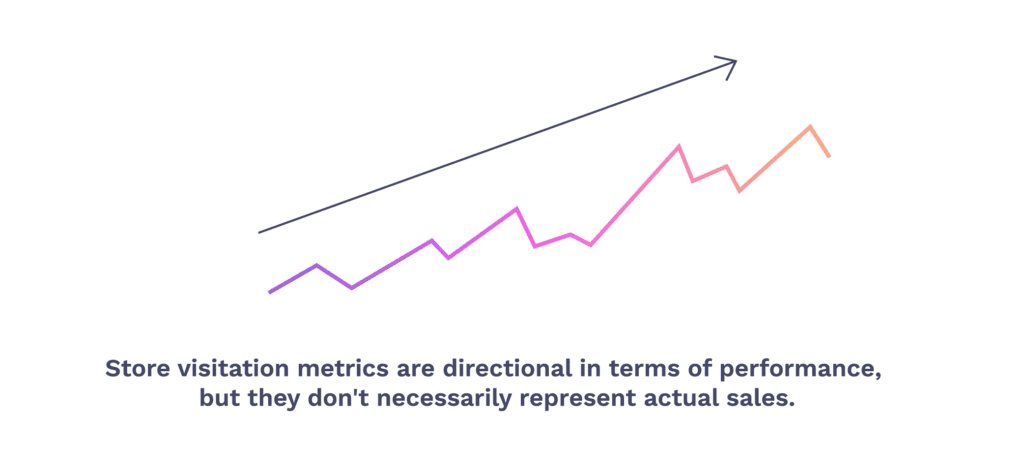In our opinion—maybe. But we caution you to be skeptical.
We understand that having offline attribution for your media is desirable. It’s important to know how your media is impacting your business—especially if the majority of your brand’s business transactions are at brick and mortar locations.
While a sales pitch for offline attribution is attractive and touted by many agencies, foot traffic metrics are rarely our recommended primary KPI for a campaign. The best way to understand how a campaign is performing is through an online tracking integration, measuring desired actions such as form submissions, email captures —and most importantly—online purchases. Almost every store traffic campaign we’ve run has led to clients questioning the authenticity of the results. Many times, store visitation metrics can seem too good to be true.
‘Foot traffic metrics are rarely our recommended primary KPI for a campaign.’
We happily accept this challenge, because we fully acknowledge that foot traffic data must be taken with a grain of salt. Here’s why.
Directional success, not measurable success
When reporting on foot traffic, it’s important to keep in mind that store visitation metrics are directional, and not necessarily indicative of actual sales. Without the ability to close the loop from the point-of-sale—typically done with an email address from a loyalty program or membership that can later be matched back to campaign exposure—there is not a way to measure sales from a physical location.
Store traffic metrics can be considered slightly more measurable for a standalone brand than for a brand that sells their products at larger retail establishments. If the locations you are driving foot traffic to sell a number of different products and services, it is possible that some of the visits tracked for your campaign didn’t result in purchases of your own product at all. This is even more likely if you are trying to measure foot traffic to popular retailers like Walmart or Target, where people might be headed regardless of ad exposure or interest in your product.

Location Accuracy
Whether or not the partner measuring foot traffic for your campaign has high quality data, there is the possibility that you’re tracking consumers who never went into the store. Say your foot traffic partner measures device signals within a 1 meter accuracy, there is potential for a device to be picked up while walking along the sidewalk in front of the store, and never actually entered.
Unique Visits vs Returning Visitors
This can be tricky, depending on the technical set-up of the campaign. But, it’s often possible for a consumer to be counted as a visit more than once. You’ll want to understand whether the metrics you’re receiving are unique, counting individuals only once. Unique visits will give you a better gauge on media performance.
You Can’t Measure Everybody
This seems fairly intuitive, considering that data privacy is increasingly more relevant year over year. For foot traffic methodologies to measure visits in a campaign, a consumer must have first been exposed to an advertisement, and then later seen at a location—with a measurable device, aka their mobile phone. Many DSPs have cross-channel capabilities to associate any divide back to one individual’s mobile device, which can in theory measure foot traffic to ad exposures across desktop, tablet, mobile and even some CTV ads. However, if the person’s device is not with them, or is turned off or on airplane mode, then it is not able to be measured.
While this example speaks more to the case of having fewer store visits than you’d expect, it’s something to keep in the back of your mind when reading through your latest report.
You might now be asking the question, when should we actually use foot traffic measurement for a campaign?
We know foot traffic data should be used directionally, and not be held as an ultimate source of truth. It can be leveraged as a gauge to get some performance insights from your campaign. Similar to a CTR or other ‘good-to-know’ metrics, you can evaluate whether performance is better or worse for specific locations or regions, or measure if a specific type of creative is more effective than another. You might consider measuring foot traffic in an instance where there is little-to-no ability for online measurement. It could be the best solution for determining optimizations and measuring success.
Before you decide to add foot traffic measurement into a campaign, you should be informed about how the data partner collects visitation data, and how they report it back to you. Here are some questions to ask when you are planning your next campaign.
1. What is the source of the visitation data? Is it SDK or bid stream?
SDK data is arguably better quality than bid stream data, which is often fraudulent. This is can get very technical, but in simple terms: SDK data can be tracked simply by the device being within the vicinity of the location, and bid stream data requires a consumer to actively be using an app/web browser that delivers ads. Bid stream data usually results in fewer store visits than SDK data.
2. Are the store visits tracked with location polygons?
Most of the quality foot traffic partners leverage polygons, which is a footprint of the actual building you’re looking to measure. Some foot traffic partners only use a radius around a lat/lng parameter. Polygons in general are much more accurate, however tracking locations within a large mall, office building, or strip mall can be more difficult to measure.
3. Are the foot traffic metrics reported on a 1:1 level, or are they modeled?
1:1 means that the metrics you’re receiving are actual visits from an individual consumer. Some foot traffic providers model data based on a small subset of data. If your data provider requires a minimum number of impressions to run a campaign, this is a red flag for modeled data.
4. Will employees be removed?
Employees can and should be removed from a campaign for more accurate results. In theory, this can effectively be done by analyzing devices that show up at the store locations in regular patterns during the day, and throughout the week.
5. What is the lat/lng resolution used to measure device locations?
The higher the resolution, the better chance the device you’re measuring is within the polygon of your store location. Look for a resolution of 6 digits or more, though 8 is desirable.
If you’re considering foot traffic measurement for your next campaign, take these questions—along with an open mind—to your media partner during campaign planning. If you have more questions about running foot traffic, we encourage you to contact us to understand how it may or may not work for your business.


